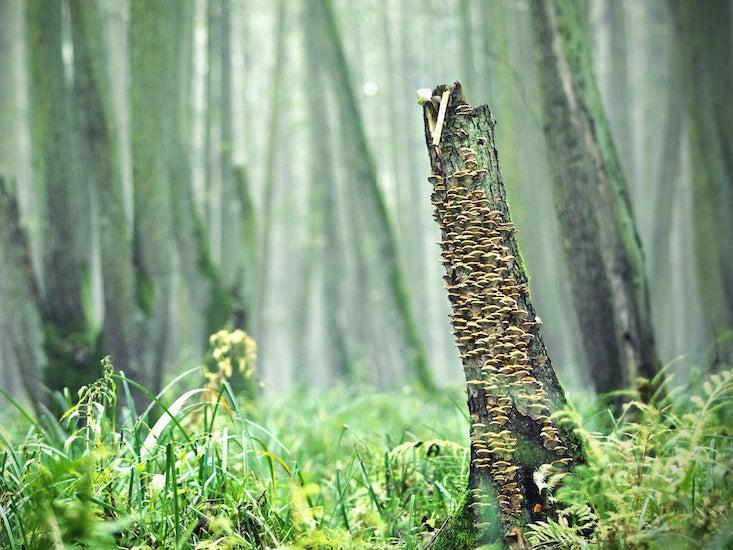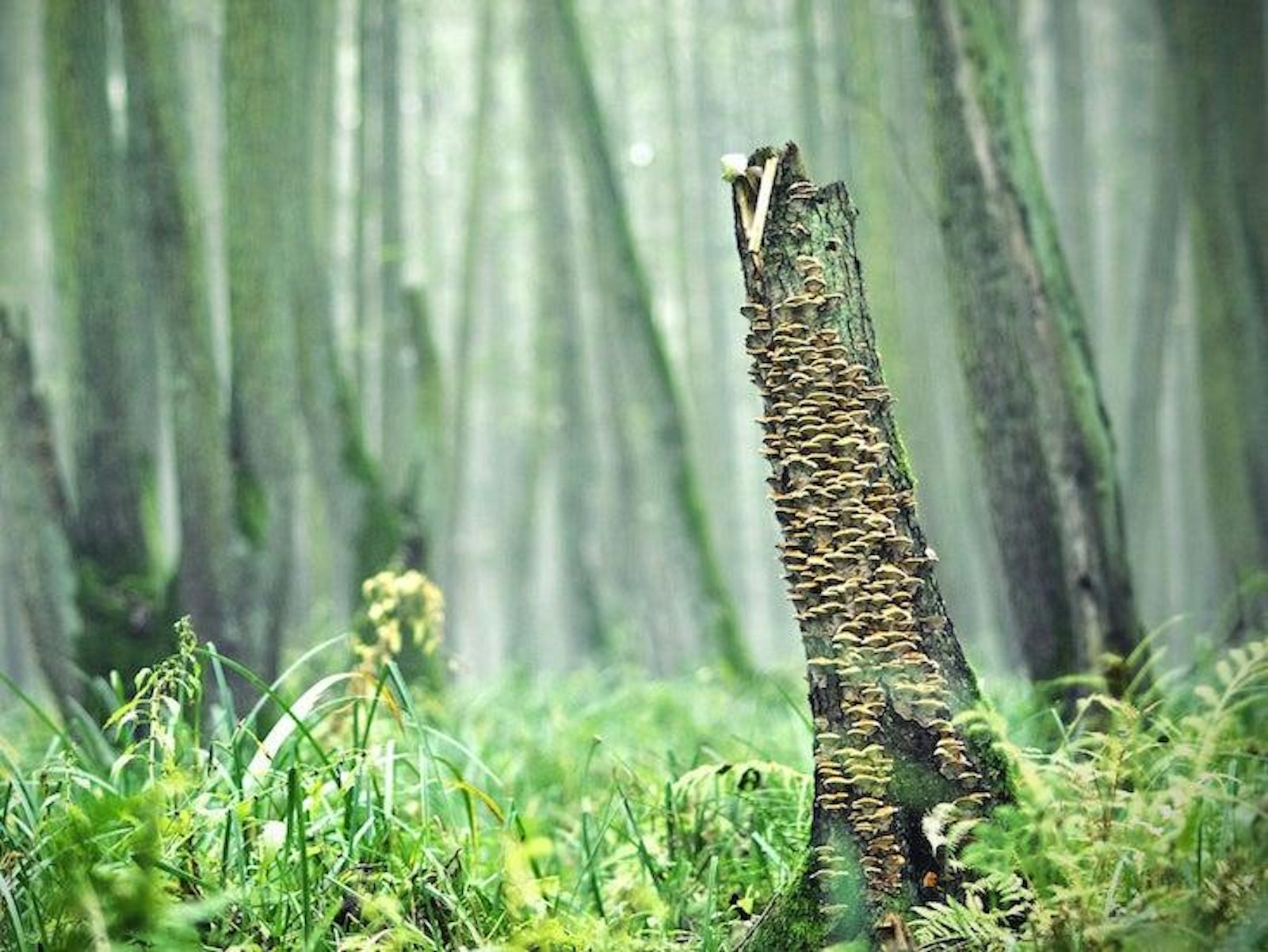
Talk of “Mother Trees,” from a scientist studying plant life, can sound fanciful, like something out of a fairy tale. Suzanne Simard is here to tell you that it’s not. For the past two decades, Simard, a professor in the Department of Forest & Conservation at the University of British Columbia, has studied an unappreciated underworld—what lies beneath sprinklings of mushrooms we tend to regard in isolation, rather than as the fruiting tips on the forest floor of a sprawling subterranean network intertwined with surface roots.
Simard specializes in the study of mycorrhizae: a symbiosis of fungi and root long known to help plants absorb nutrients from soil. Mycorrhizae-linked trees, she has shown, form networks, with individuals she dubbed Mother Trees at the center of communities that are in turn linked to one another, exchanging nutrients and water in a literally pulsing web that includes not only trees but all of a forest’s life.
“What we’re doing is not okay. The climate scientists have measured that salvage logging actually accelerates the emissions of carbon from the soil.”
Simard has unearthed insights into something akin to cognition in plants—their memories, of nitrogen levels supplied by salmon, for instance, as well as communication, not only within but between a number of interdependent communities. “When you’re walking in a forest,” she says, “not only are there probably five or six different mycorrhizal networks going on, but there’s the networks that are going on with the other species.”
Everyone knows forests are alive, but Simard helps us see that life anew. Even dying, for a tree, is not what it seems.
In one of your papers you talk about ecological cycles of salmon migration and the distribution of nutrients through forest communities. You write, “We are now examining whether these salmon nutrient memories are transmitted from tree to tree. The spreading of the salmon memory, the telling of the story allows the trees, fungi, bears, and salmon to collaboratively inform the productivity and health of the ecosystem.” Can you talk more about what that means?
When indigenous people harvested the fish, they took the guts of the fish and returned them to the river to replenish the river. Or they would bury the guts at the base of a tree to replenish the tree. The bears and wolves carry those salmon up, and their populations depend on them. And the trees are replenished by this salmon nitrogen and grow bigger, and shade the rivers, and provide habitat for bears and eagles.
The health of the people was linked to the health of the salmon population. The salmon population depends on how the people treat the salmon. The health of the forest is dependent on the salmon being able to migrate up into the streams and spawn healthy populations. We’re looking at those linkages now.
Where does plant communication fit into that? You could describe those connections and interactions purely in ecological terms without invoking plant intelligence.
That’s true. What we’re doing is looking at the mycorrhizal networks of forest that have different populations of salmon in them. We’re looking at how the mycorrhizal networks that link trees change depending on whether there’s salmon or not. The next step is to start labeling trees. We’ve started doing that, to see how nutrients flow from tree to tree, but we’re at the very first stages of that.
The other thing we’re doing is to reconstruct some of the stone fish traps built by indigenous people that were dismantled by the Department of Fisheries and Oceans Canada. Then we’re going to measure how salmon nitrogen changes in the forest as a result. Hopefully, the next step will be this tree-to-tree communication of those salmon nutrients.
We also know that nitrogen doesn’t just end up in the trees. It ends up in the understory of plants and the insects.
Is the idea that certain trees would be sharing not only with others of their kind, but with other plant communities as well?
Yes. The other parts of the plant community.
When I walk into a forest should I be seeing not just a bunch of isolated trees, nor one uber-organism comprised of them all, but rather many different communities interlocking with one another?
There’s populations in communities. There’s these populations of species that have their own population dynamics, but they are embedded within a community of all kinds of species and they’re interacting with them. So when you’re walking in a forest not only are there probably five or six different mycorrhizal networks going on, but there’s the networks that are going on with the other species. For example, the nest webs of birds. They have their own web going on. They’re interacting with each other. There’s networks that interact with networks and they are all interdependent.
What’s the connection between cavity-dwellers and fungi?
My neighbor in the office next door studies the nest webs of cavity-nesting birds. She’s really pioneered this idea. But basically, a tree starts to die and primary cavity-nesters, like woodpeckers, will come in to build a cavity so they can lay their eggs. They use that cavity for a while. But the tree goes through this dying process. It dies and it starts to decay. And the hole that cavity nester made, it changes too. So the shape of it changes. The size of it. And it will only be a safe place for that bird to lay its eggs for a few years before the cavity is too big.
So then the bird will abandon the nest and a bigger bird will come in. Maybe instead of the woodpecker, you’ve now got an owl using that nest. And then the owl will use it for a period of time until the tree will decay even more, and shrink down, and go through its dying decay process. The owl will abandon it and a bigger bird will come in. Maybe a duck. And then it will abandon the cavity and something even bigger will come. Maybe a marbled murrelet or eventually maybe even a bear.
It’s a web of nests, right? They use each other’s nests. That’s a resource that they use and share in this big web. And fungi are partly the decay organisms. If we think of saprotrophs as decaying that tree by exuding their enzymes, they help the tree go through this recycling of its energy. One of the things I’ve studied is how a dying tree of course shuffles carbon to its neighbors through its mycorrhizal fungi, which will link up to other trees. So that’s going on at the same time.
That’s a whole other group of fungal organisms. So there’s the saprotrophs, there’s the mycorrhizas, there’s also the pathogens. The fungi are involved in this process in multiple ways depending on what their life strategy is.
Then of course the squirrels and birds that fly out of the nest have spores on their legs. Take a squirrel, for example: if a squirrel is using that nest, it will harvest pine cones and make middens. And it also eats mushrooms and truffles. And so the spores of the fungi end up in the middens of seeds and they become inoculated with fungi. Then the seeds will germinate. Then the squirrel will go back up to its nest in the dying tree and bring some inoculum with it, some saprotrophs maybe. You san see how quickly they are all linked together.
I wanted to ask about death as well. Most people would look at a tree and, if they see that it’s no longer growing any new leaves, they say that the tree is dead. How long does the tree go on communicating even when it’s “dead”?
As it’s dying and decaying, there’s all kinds of things going on. There’s a dying process, and I don’t think we totally understand it, but from a mycorrhizal point of view—and keeping in mind that there’s also this huge communication going on above-ground with these volatile organic compounds moving across the forest through the air—below ground, as the tree is dying, as long as there’s a carbon source from photosynthesis, it will support the mycorrhizal fungi.
As the tree is dying, it actually transmits or communicates its carbon to other trees. And the fungus probably has a lot to do with how that’s done, because it’s going to invest in where it’s going to get its energy from multiple sources. Once the tree is dead, it only takes about a year for the fungus to completely disappear. It doesn’t take long—but that process of dying, it can go on for years. And the fungi are around. They’re associated with that tree through the whole process.
They’ll eventually abandon the dead tree. But even then other plants will start to grow on that dead tree. In our coastal forest, Western hemlock seedlings establish on old logs or old trees. And we know that those living trees around them are linked to those seedlings through the log. The mycorrhizal network just goes right through it. And so the life of that log goes on in those new seedlings establishing on the dead log. They’re linked to the old trees and transmitting carbon into them.
This death thing isn’t just like, step one, step two…it’s a process, and that dead thing is never really dead. There’s living things that are growing on it right away, all the way through.
That brings to mind the practice of salvage logging…
Plants are a source of materials, and a source of wealth, too. And with salvage logging it’s like, where does this end? What we’re doing is not okay. The climate scientists have measured that salvage logging actually accelerates the emissions of carbon from the soil.
But also, what is the purpose of this salvage logging? Is it really because we need the materials? I think that it’s just a big greedfest, to be honest. We know there’s a purpose to those dead trees. They’re giving back to the community for the next generation. They’re holding down the network. They’re providing homes for the mycorrhizas that are linking to new seedlings. They’re providing homes to critters that cycle the nutrients. There’s a purpose to them. And we’ve just said that there’s no purpose other than in the sawmill. It’s wrong.
Brandon Keim is a freelance nature and science journalist. He is the author of The Eye of the Sandpiper: Stories from the Living World and Meet the Neighbors, forthcoming from W.W. Norton & Company, about what it means to think of wild animals as fellow persons—and what that means for the future of nature.






























